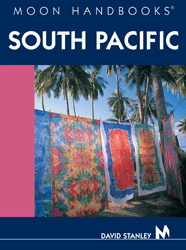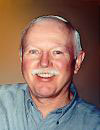 Here’s the latest in our new monthly series of interviews with travel writers. When you call David Stanley, author of all eight editions of the 1,091 page “South Pacific” travel guidebook a widely traveled author, that’s a gross understatement. He has actually spent much of the past three decades on the road, criss-crossing six continents overland and has visited about 200 counties –– with 54 remaining to see.
Here’s the latest in our new monthly series of interviews with travel writers. When you call David Stanley, author of all eight editions of the 1,091 page “South Pacific” travel guidebook a widely traveled author, that’s a gross understatement. He has actually spent much of the past three decades on the road, criss-crossing six continents overland and has visited about 200 counties –– with 54 remaining to see.
We’re honored to interview David whose travel guidebooks to the South Pacific, Micronesia, Alaska, Eastern Europe, and Cuba opened those areas to budget travelers for the first time. Below are his answers to our questions. To win a copy of this book, see below!
1. What was the subject of your first travel article/book?
My first book was Moon Handbooks South Pacific which Bill Dalton and I co-authored in 1979. Before that I’d sent reader feedback to the authors of several travel guides to Asia and South America, which was how I got in touch with Bill. I used his Indonesia, A Traveler’s Notes on a long trip through the region, and I sent him several pages of corrections when I got home. A lively correspondence developed, and when I told Bill I was planning to tour the South Pacific in 1978, he suggested we write a guide together. I did the field research and Bill assembled it all in book form. There weren’t any travel guides to the Pacific islands in those days, so it really was a first. Bill dropped out after the first edition, and I researched and wrote the seven editions which followed.
 2. What is your favorite place to visit in the South Pacific or otherwise?
2. What is your favorite place to visit in the South Pacific or otherwise?
My favorite South Pacific country has always been Fiji. The variety of things to see and do there is unparalleled, and it’s a lot less expensive than French Polynesia, which I also like. Samoa is a close second, mostly because of the intact Samoan traditional culture. Sleeping in a thatched Samoan beach fale, you know you’ve really arrived in the South Seas. The Solomon Islands are my favorite South Pacific adventure destination, but you’ve got to be prepared to rough it as this is no manicured resort. The Solomon Islanders are great and it’s always a thrill to board a rusty copra boat to some outer island. Apart from the South Pacific, my favorite country is Cuba which I’ve visited 25 or 30 times. I wrote the first two Lonely Planet guides to the country.
3. What is the worst place you’ve ever visited?
This changes with time and no place is entirely bad. As a traveler, I’ve faced hostile reactions from some local residents in Albania, Jamaica, and Mali, largely due to economic or political problems unrelated to my visit. I was once subjected to prolonged questioning by immigration officials in the Solomon Islands because my trip happened to coincide with a visit by Pope John Paul II and I was taken for an undercover journalist (all media coverage of the Pope’s visit had been banned). They only let me go after confirming that I’d spent the entire afternoon of the Pope’s visit chatting with a Presbyterian minister at his home.
4. What’s on your must-visit list?
There are still 54 countries and territories around the world that I haven’t yet visited, and I try to get to five or six of them every year. Central Asia (Kazakhstan, Kyrgyzstan, Tadjikistan, Turkmenistan) is high on my list for next year. I’d originally planned to go to Lebanon, Yemen, and Kuwait, and may still do so if the flights are operating normally again. It’s been my experience that the “dangerous areas” featured in the headlines are often the safest and most interesting places to go. I went to Dubrovnik in 1993, and instead than smoking ruins, I found everything about the same as it had been on previous visits, only the golden hordes of the tourists were gone. Afghanistan in 1981 was also very special and I wish I’d stayed longer, despite the tanks guarding the entrances to the towns.
5. What is your philosophy for traveling?
My philosophy is pretty simple: Do it the way the locals do it. This strategy not only saves you money but it puts you in direct touch with the local population. Of course, in some parts of the world (Africa, Asia especially), it’s often just too hard to live like a local. I spent a year in India in the late 1970s, and I was able to get around quite comfortably by following the advice and suggestions of traveling salesmen I met on Indian trains (there weren’t any travel guidebooks to lean on back then). I dressed in a night watchman’s uniform and grew a long beard, which helped me to fit in. In China in the mid-1980s (where I met my wife, a Dutch fellow traveler), we got along well because she was a woman and about the same height as the local Chinese, thus we got everything for the local price. If I tried to pay, it was always several times more expensive. I haven’t the slightest interest in taking all-inclusive package tours or consumer cruises as these tell you little or nothing about the place you’re visiting.
6. Who’s your favorite travel author?
I guess I’d have to say Paul Theroux because he’s so honest and irreverent. The Happy Isles of Oceania appeared in 1992, and none of the more recent travel books about the South Pacific come even close. I guess Rolf Potts is my favorite travel blogger.
7. What is one piece of travel advice you never told anyone?
If you go on a trip which lasts over 365 days, you’ll never be able to stop.
8. How has publishing this book changed your life?
Travel writing gave me a purpose for traveling and financed my trips in the early days. I was just lucky to get in when I did. These days, newbie guidebook updaters are mere pawns of the publisher. Tony Wheeler, the founder of Lonely Planet, signed me up to research and write the first edition of Eastern Europe on a Shoestring because he wanted to lure me away from his competitor, Moon Handbooks. This worked for seven years, until I got burned out on Eastern Europe. Then he convinced me to take on Cuba, which lasted another five years. Now I no longer write for Lonely Planet and have returned to my roots in the South Pacific. As I speak, I’m preparing the eighth edition of Moon Handbooks Fiji for publication in 2007. I’d like to retire, but several of my trips have been longer than 365 days.
NOTE: The first 3 North American Vagablond readers who submit their best answer to one of this article’s questions will be eligible to win a copy of this fascinatingly detailed travel book. Sorry, no Contributors are eligible. Once I select the three winners, I will contact you separately for your street addresses.
Moon Handbooks South Pacific
8th Edition
David Stanley
ISBN 1-56691-411-6
$24.95
Save when purchasing through Amazon.com.